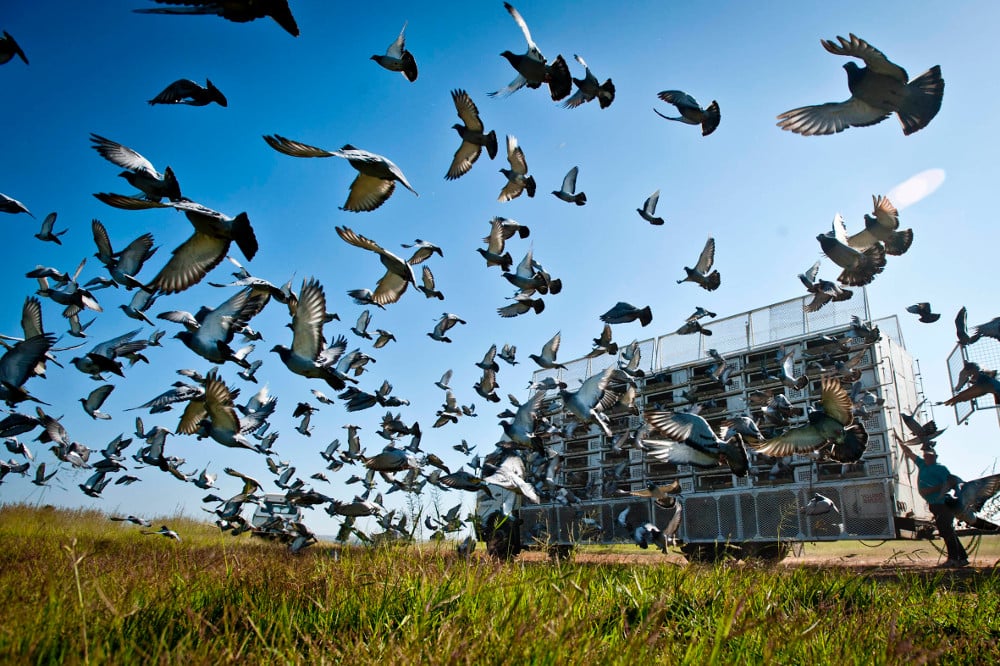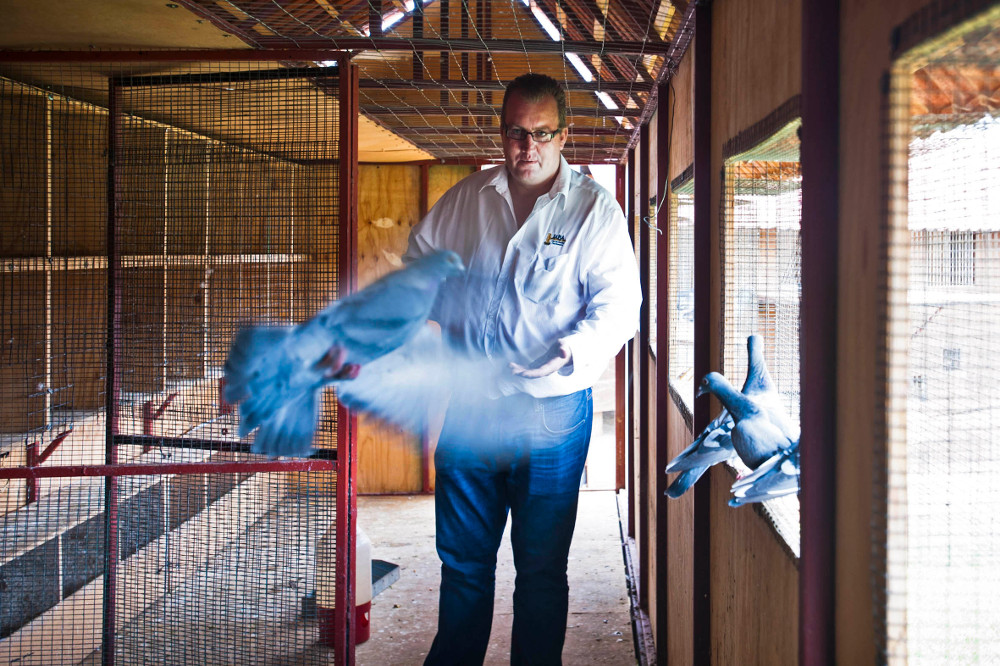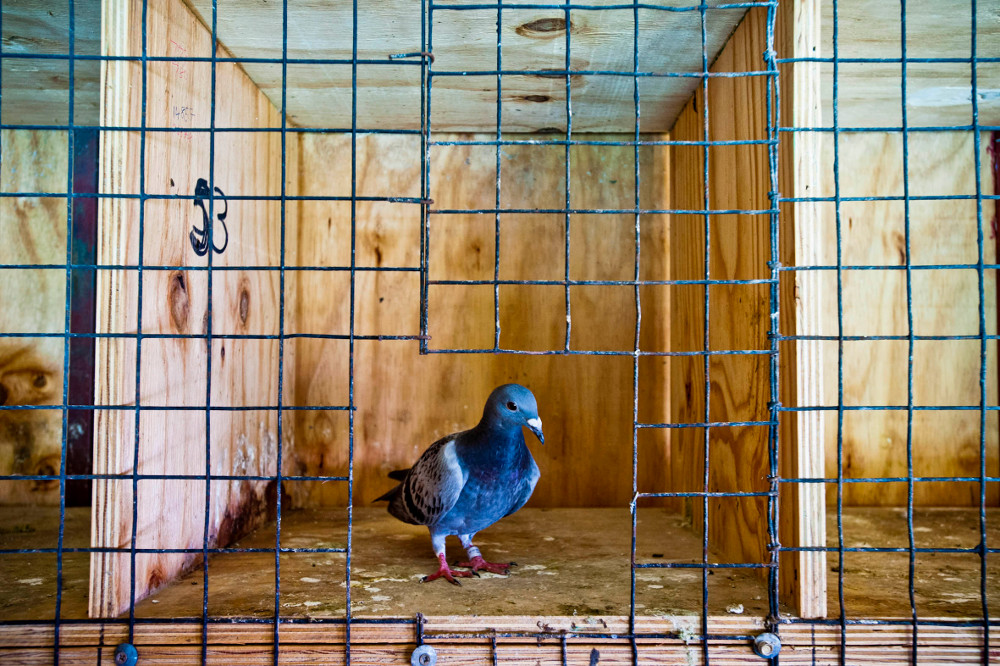If horseracing is famously the sport of kings, then flying pigeons is the more prosaic dominion of solid citizens with a loft in the yard. This is confirmed by Martin Beneke, who is part of a family consortium that has three birds flying in Saturday’s Million Dollar Pigeon Race.
“Not every man can breed for Turffontein but even an oomie on pension can put a few birds in a loft,” he says. “It’s the poor man’s horse racing.”
The Beneke consortium’s three hopefuls will be released from Hopetown on Saturday morning along with about 2 400 other birds, most of which are internationally owned. With names such as Justin Bieber, Usain Bolt, Olympic Wonder and Jiffy 1 in their midst, the birds will fly through the heat of the morning along what is called “the road” in pigeon-fancying parlance.
There were once, I am told, any number of “Lance Armstrongs” flying the road, although in recent years such birds have become as rare as a clean man in the peloton.
Counter to received wisdom, Justin and Usain will not be flying to their final destination in Linbro Park east of Johannesburg in a straight line, but rather “countersteering” themselves along the way. There are many reasons for this, including dealing with prevailing winds and possibly showers of rain, following their instinct for what constitutes the quickest route and avoiding raptors and hazards.
Depending on the strength and direction of the wind, they will take between seven and eight hours to fly the nearly 600km from south-west of Kimberley, meaning that the pigeons are flying at a stately 80km/h. “We’ve recorded speeds of 160km/h with strong winds from behind. We call that a ‘blow home’,” says Beneke. “Once we released them from Matjiesfontein [in the Karoo], nearly a thousand kilometres away, and they were back in under seven hours.”
Holy grail
The holy grail of pigeon racing is to produce a bird perfectly suited to all conditions, neither a sprinter nor what Beneke calls “a plodder”, a bird neither too fat nor too thin, neither too young nor too old. Understandably, such birds are difficult to breed, neither the tortoise nor the hare, but a long-distance champion that can head for the “big smoke” at a steady rate, only coming to ground for water and not allowing thunderstorms or cellphone towers to scramble their instinct, to return to the Linbro Park landing strip.
Beneke calls such a bird a “Bruce Fordyce” and he will die a contented man if he perfects the secret of breeding one. In the meantime, he will have to settle for knowing that the consortium’s three birds (youngish birds are the best racers and will only be at their best for three or four years) have the pigeon equivalent of the right stuff. Like everyone else, he gets progressively more and more nervous as the birds’ expected time of arrival draws near.

In the months leading up to the Million Dollar Pigeon Race, the birds are released from increasingly distant places to develop their skills. (Photos: Delwyn Verasamy, M&G)
He will know whether he can start clicking his fingers for magnums of champagne by about 5pm.
For about the past six months, the birds have been released further and further afield from their loft, dashing for home in a series of races within races, called hot-spots. This training is thought to help them image – and possibly memorise – the lie of the land, although recent studies by geophysicists have posited the idea that pigeons are sensitive to low-frequency noise trails, undetectable by the human ear. They apparently latch on and follow them, steering a relatively faultless route home.
But however they fly their way home, it is part of the sport’s enduring romance that for the most part they will return safely.
Race route
The land across which they fly is mainly the scrub of the arid and semiarid Karoo, although they will also fly across the Riet and the Vaal rivers, the Bloemhof Dam and the unending mealie fields of the North West, moving up to the Highveld and tacking a course for home in the vicinity of Hoopstad, Leeudoringstad and Wolmaransstad.
It is unlikely that they will be tempted to stop and sample the splendours of the towns over which they fly, but they are pigeons and we do not see the world through their dark and inscrutable eyes, although Beneke himself, like fanciers in general, is not at a loss for a theory.
“I believe that when pigeons fly over the Free State they fly upside down,” he says with a hearty laugh.

Martin Beneke shows off some of his pigeons in their loft in Roodeport, Johannesburg.
In the same way that good pigeons come from established racing bloodlines, so fanciers tend to have the sport in their genes. Martin’s dad, Karel, had a loft in Vryheid in the 1960s and the lore of racing was always a subject for dinnertime discussion.
Martin didn’t come to the sport immediately but he remembers being taken to the Sun City Super Bowl many years ago by his brother Hein – a surprise birthday present. The occasion was the final hours of the Million Dollar Race when Sun International was still the host, and he was amazed by the excitement and thrill of seeing whose bird was going to materialise out of the sky and be tagged first.
Worry beads and lucky shirts
It will be exactly the same late on Saturday afternoon when owners from around the world gather at the Hyatt Regency hotel in Johannesburg’s Rosebank to worry at their beads and sit in their lucky shirt in their lucky corner.
There will be sheiks from the Emirates, who have flown in on their private jet especially for the occasion, and the movers and shakers of the sport, like the German, Alfons Klaas, and the Czech, Karel Klements, the men to whom the Chinese go when they want to get a jump on everyone else to start their pigeon dynasty.
As they all watch the big screen for evidence of their birds’ homecoming to the Linbro Park lofts, all men, for a precious moment, will be equal. Beneke, a used-car salesperson and auctioneer with a lot on Johannesburg’s Ontdekkers Road, will know that he has as much chance of winning the race as they do. There will be the dignity of equality in the room.

Racing pigeons is ‘poor man’s horse racing’, says Martin Beneke.
The drama of the race’s final hour is enhanced by the fact that owners know well that landing first doesn’t mean winning the first prize of $150 000, because the birds might not head for the loft immediately.
They might dawdle, or wander off, or be attracted by a member of the opposite sex. Only when they enter the loft and are electronically tagged can they be said finally to have arrived.
This, beyond doubt, is the most hair-raising time of the day, time that makes getting rid of an old Tazz to an uncertain punter seem like a doddle by comparison.
Battle survivors up against an unseen enemy
The fate of pigeons has come a long way since the Paris Olympiad of 1900 in which Belgium’s Léon de Lunden won a gold medal – for shooting them.
Despite this, the SPCA, which will be in attendance throughout the Million Dollar Race, has strong views on racing them over such long distances, believing it exposes them to unnecessary danger, possible thunderstorms and heat exhaustion.
But the largest threat comes from cellphone masts, which could scramble their homing instinct.
When the cellphone tower threat was first discussed, Peter Bryant, of Britain’s Royal Pigeon Racing Association, said: “Their instincts carried them back through hostile fire and they were even parachuted to members of the Resistance and made their way back from that in World War II. It would be ironic if they were now victims of an unseen enemy.”